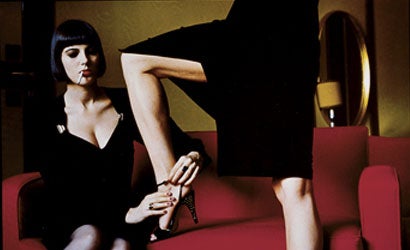Art: A Fashion History
A brief and entirely subjective history of fashion imagery.

Fashion photographers are tastemakers and workhorses, artists and salesmen. Their imagery reflects the culture they work in, but there is no denying their influence in shaping culture as well.
When the first illustrated fashion magazines emerged in the 1890s, the ideals of fashion rested squarely with an aristocracy of style. In a large sense, the beginning of fashion photography and its profound cultural impact can be traced back to the 1920s, when a pioneering fashion photographer, Baron Adolphe de Meyer, began using society beauties and famous actresses as models, as in his 1920 photo of Helen Lee Worthing (Right). His images were painterly depictions of women as immobile and immortal icons.
De Meyer was brought from Europe to wo
Like his peer Avedon, Henry Clarke studied at the feet of Brodovitch and understood that fashion photography and reportage could go hand-in-hand. In images like his 1955 photo of a model in Chanel (Right), there is consummate craft and cool wit. As the 1950s segued into the 1960s, fashion turned upside down. Tastes had always been created by the powerful as high style; now style was beginning to come from other parts of society, especially the youth culture.
Photographers like Bob Richardson used small SLRs to capture the energy and drama of self-discovery rather than the ostentation of formal style, as in his 1966 shot for Vogue Paris (Left). Richardson depicted sex, drugs, and violence as part of fashion, anticipating cultural changes to come.
Helmut Newton looked at the sexual revolution and changing class values with a decidedly European attitude. He used sexual provocation and arch symbolism to depict a modern world in which women were aggressive and lustful — full participants in the fashion and fantasy of the time. In his “Amica, Milan, 1982” (Right), Newton renders the erotic adventures of the characters he has created. He was unafraid to imbue his images with corruption and an unspeakably intriguing sense of unease.
Deborah Turbeville depicted women’s sexuality in a different way, as seen in a classic image from 1975 (Left). Turbeville once said that Newton “put down” women in his images. Turbeville’s women have desires that are private and unassailable.
Like Helmut Newton, Guy Bourdin employed themes of sex, violence, and glamour. But while Newton excelled at capturing the erotic fantasies of modern men and women, his contemporary turned inward to delve deeply into his own desires. The influence of surrealism was part of the DNA of Bourdin’s work, as in his 1975 shot for Charles Jourdin (Right).
Later in the decade, a group of young fashion photographers in Paris began to make images that flew in the face of the highly stylized work of Newton and Bourdin. Among this group was an American, Arthur Elgort, whose career is still going strong. Elgort’s images unapologetically adore beautiful women, who are often seen on the streets of great cities (Left).
The 1980s saw one of the true revolutions in fashion photography — the eroticism of men — thanks in large part to the work of Bruce Weber, whose advertising imagery for Calvin Klein underwear became an iconic part of the visual vocabulary of the decade (Right).
With the Reagan era’s style of broad-shouldered power fashion and curvy models ending by the ’90s, new ideas began to take hold. British photographer Corinne Day photographed waiflike model Kate Moss at Moss’s home in 1993 (Left), creating a visual sensation. The era of indie-rock and heroin chic was at hand.
The most controversial — and best-known — face of fashion photography today is Terry Richardson, son of Bob Richardson. While fashion imagery has often borrowed from the movies, Richardson specifically borrowed from porn films, shooting with inexpensive point-and-shoot cameras and placing his own bespectacled face in his pictures (Right).